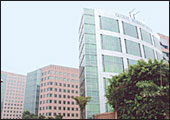 |
| Double take: Mukesh Ambani is riding
on growth |
You have to hand
it to Mukesh Ambani. The man has inherited his father's ability
to think really big. In April, he unveiled plans to set up a 29
million tonne oil refinery in Jamnagar at a cost of Rs 27,000
crore. He followed this up in June with an agreement with the
Haryana government to build the country's largest Special Economic
Zone (SEZ). The numbers tell the story: the Reliance SEZ will
be spread over an area of 25,000 acres, entail an investment of
Rs 25,000 crore and generate a turnover of Rs 50,000 crore in
its first year of operations. The land acquisition process will
take about three years and the SEZ is expected to be completed
within two years thereafter. "It will be the most competitive
SEZ in the world," Ambani told a press conference-his first
in one-and-a-half years-in Chandigarh immediately after signing
the deal.
The next stop on his agenda was Kolkata, where he announced plans
to invest Rs 4,000 crore on two projects-the rollout of an agri
retail-chain-cum-dairy and another one to bring natural gas from
Reliance's fields in the Krishna Godavari (KG) basin in Andhra
Pradesh to the state for industrial projects and other usergroups.
"The agri-retail chain will be in place in about three years,"
says Ambani. "The objective is to link farmers with consumers
by transforming the agri-business in the state into an agro-processing
one." Ambani's ambitious Rs 30,000-crore retail jigsaw is
gradually taking shape.
Since the partition of the Reliance empire
last year, Mukesh Ambani has announced projects worth Rs 80,000
crore. That's a large enough pie for almost everyone. But only
the very naïve will bet that Ambani won't chew off even more
in the days to come.
-Krishna Gopalan
NUMBERS
OF NOTE
3.97 lakh: The number of passengers
who used the net to book railway tickets in May 2006 against 1.81
lakh in May 2005
$250 million
(Rs 1,150 crore): Total size of India's animation industry,
according to Nasscom estimates. With a 30 per cent annual growth
rate, the market is expected to touch $900 million (Rs 4,140 crore)
by 2009
1 million:
The estimated number of NGOs in India
158: The
rank of Oil and Natural Gas Corporation which had a market capitalisation
of $41.9 billion (Rs 188,550 crore) on March 31, 2006 in the 10th
annual Financial Times Global 500 listing of the world's most
valuable companies
7.85 lakh:
Total number of small cars manufactured in India in 2005-06. Only
Japan, with 17.7 lakh units and Brazil with 8.5 lakh, make more
small cars than this
4.45 million:
The number of industrial units in Tamil Nadu, the highest in the
country
1,000: The
number of jobs ICICI OneSource will create at its two nearshoring
centres in Northern Ireland over the next two years
$1 billion
(Rs 4,600 crore): The relief money meant for victims of Hurricane
Katrina lost to fraud; bogus claimants spent the money on Hawaiian
holidays, football tickets and diamond jewellery
Rs 5,000:
The amount the Central Information Commission ordered the central
government to pay to an applicant whose efforts to get information
were frustrated by CGHS officials in Pune
18.3
per cent: The combined global market share of Nokia and Siemens,
making it the third-largest telecommunications equipment vendor
$11.2
billion (Rs 51,520 crore): Amount raised by The Bank of China
in a Hong Kong IPO, the world's fourth-largest
13,500:
The number of cars Volkswagen aims to sell this year in India
NOTED
 AWARDED:
To Sunil Mittal, CMD, Bharti Airtel, the CEO of the Year
Award, at the Frost and Sullivan Asia Pacific ICT 2006 Awards.
The award took into consideration his leadership, the revenue
growth of his company, and its market share and financial achievements
in 2005. AWARDED:
To Sunil Mittal, CMD, Bharti Airtel, the CEO of the Year
Award, at the Frost and Sullivan Asia Pacific ICT 2006 Awards.
The award took into consideration his leadership, the revenue
growth of his company, and its market share and financial achievements
in 2005.
REOPENED: Border
trade between China and India at the historic Nathula Pass after
more than 40 years. The pass, at an altitude of around 4,300 metres
(14,100 feet) is scheduled to open on July 6, and will facilitate
trade between Sikkim and West Bengal in India and southern Tibet.
RECORDED: A
29.59 per cent surge in India's exports in May to $9.35 billion
(Rs 43,010 crore) compared to $7.22 billion (Rs 31,768 crore)
in the same month last year. Imports grew at 21.67 per cent to
$13.19 billion (Rs 60,674 crore) against $10.84 billion (Rs 47,696
crore) in May 2005.
RANKED: India,
as the #1 location for call centres and back office functions,
in the Ernst & Young European Attractiveness Survey 2006. The
survey puts the US and China as the top two preferred countries
for investment. India is ranked fourth.
RECORDED: An
increase in the number of millionaires around the world to an
all-time high of 8.7 million over the past year. This growth was
fuelled by a sharp increase in emerging markets such as South
Korea, India and Russia. The 10th annual World Wealth Report was
put together by investment group Merrill Lynch and consulting
firm Capgemini. According to the report, India has 83,000 millionaires
up from 70,000 in 2004.
 RETIRED:
Goody the tiger, the smiling mascot of paint company Goodlass
Nerolac. There's no substitution planned for Goody, born in 1970.
As part of Goodlass Nerolac's corporate image makeover, the company
is being renamed Kansai Nerolac Paints Ltd. RETIRED:
Goody the tiger, the smiling mascot of paint company Goodlass
Nerolac. There's no substitution planned for Goody, born in 1970.
As part of Goodlass Nerolac's corporate image makeover, the company
is being renamed Kansai Nerolac Paints Ltd.
LOWERED: To Class
X, the registration eligibility for the chartered accountancy
(CA) course. The Institute of Chartered Accountants of India has
also reduced the duration of the course from five years and three
months to four years.
FOREIGN
ARCHITECTS THE NEW RAGE
 |
| New design: Focus on foreign architects |
It's
a new marketing tactic. builders are increasingly turning to foreign
architects to design shopping malls, condominiums and complete
satellite townships. "This trend is here to stay," says
Sanjeev Srivastava, Director, Assotech, a Delhi-based real estate
developer, "because design parameters in India are fast catching
up with the best in the world."
Does this mean Indian architects are not
good enough? Real estate consultants point out only a few Indian
architects can be compared to the best in the world. And those
that make the cut often lack the scale required to take on very
large projects. "Moreover, most Indian architects don't have
up-to-date knowledge about international norms, which is sine
qua non for attracting foreign retailers," says Sanjay Dutt,
Executive Director, Cushman & Wakefield, a leading real estate
consultancy firm.
Foreign architects, on average, charge three
times as much as their Indian counterparts. Top Indian architects
charge Rs 20-25 per sq. ft; firms from the US and the UK charge
Rs 60-75 per sq. ft. But builders say customers are willing to
pay a premium for such buildings. "If you want a good design,
you will have to cough up good money," asserts Srivastava.
Dutt, however, feels that costs will come down over time as more
foreign architects set up shop in India.
-Aman Malik
|





 AWARDED:
AWARDED:
 RETIRED:
RETIRED: